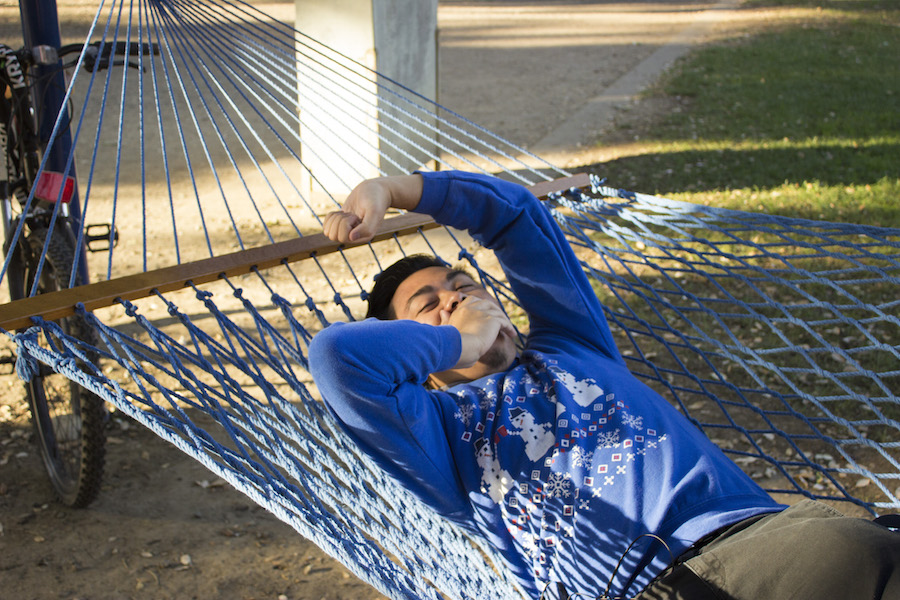
Students learn about the importance of sleep, receive nap kits
UC Davis’ Student Health and Counseling Services (SHCS) hosted its annual Nap Campaign from Nov. 7 to 10. The event celebrated healthy napping habits with over 800 participants given nap kits, which included sleep masks, earplugs and cards with information about naps.
On Nov. 7, students could pick up free nap kits at the Women’s Research and Resource Center (WRRC), the Student Community Center’s Reflection Room and the West Quad.
The following day, the campaign continued at the Student Community Center (SCC), where students received free buttons and were taught about the three different types of naps: planned napping, emergency napping and habitual napping.
Planned napping is when an individual naps before becoming sleepy with the knowledge that they will be staying up later than their regular bedtime. Emergency napping happens when one is suddenly tired and cannot continue their current activity, like driving or working. Habitual napping is napping at the same time each day.
On Nov. 9, the Nap Campaign tabled at the Memorial Union to decorate nap masks for students.
Emilia Aguirre, a sexual and mental wellness health educator from the Health Education and Promotion Department, viewed the Nap Campaign as a tool to encourage and educate students on proper napping.
“The main goal of the Nap Campaign is to encourage students to take 20 to 30 minute naps to improve concentration, increase energy levels and to help boost academic performance,” Aguirre said via e-mail.
Nisha Patel, the mental wellness student coordinator from SHCS’ Health Education and Promotion Department, said that the campaign’s goal was to remove the negative stigma associated with adult naps.
“There is a prevailing stigma that napping is unproductive behavior, but in reality, napping allows for greater productivity when executed in the right manner, for the recommended lengths of time and in proper environments with dim lighting and minimal distractions,” Patel said via e-mail.
Patel said the main focus for this year’s campaign was naps as a tool to combat drowsy driving and avoid the fatal consequences lack of sleep can have on individuals.
In a SHCS blog post written by Patel, she wrote about how drowsy driving is statistically as dangerous as drunk driving, and recommended that students utilize ridesharing technology and take naps to avoid drowsy driving.
“Recent studies have shown that ‘drowsy driving,’ or driving tired after too little sleep, is just as dangerous as drunk driving,” Patel said in the blog. “Drowsy driving is tied to 1.2 million car crashes per year and results in up to 500,000 injuries and 8,000 deaths.”
In the blog, Patel wrote that driving after being awake for more than 18 hours is equivalent to a blood level alcohol of 0.05, and after 24 hours without sleep it is like having a blood alcohol level of 0.10.
“Just like being drunk, fatigue dulls your decision-making skills, reaction time, situational awareness and memory — all of which creates a perfect, and deadly, storm when getting behind the wheel,” said Patel in the blog post.
According to the UC Davis Nap Map, the top three nap spots on campus are the SHCS Mind Spa, the SCC Reflection Room and the WRRC Righteous Babes Lounge and Reading Room.
Tommy Hoang, a third-year biotechnology major, didn’t know what a nap kit was before participating in the Nap Campaign.
“I thought it was like a pillow and some earplugs, but it was actually a sleeping mask with earplugs in a plastic bag,” Hoang said via e-mail. “I chose the library [as my favorite nap spot] because it’s quiet and because there [are] empty corners in the back that are perfect to nap in.”
More sleeping and napping tips can be found on the SHCS website.
Written by: Yvonne Leong — campus@theaggie.org



